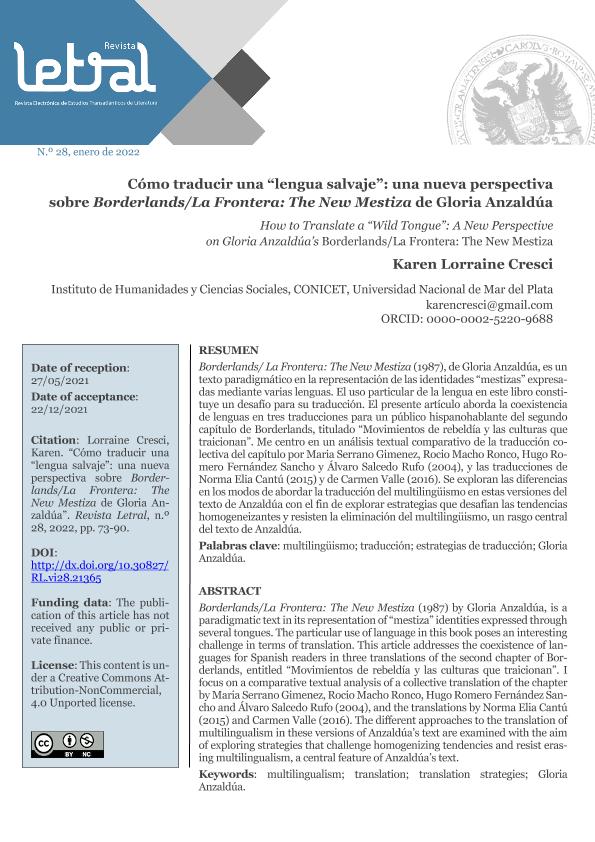Mostrar el registro sencillo del ítem
dc.contributor.author
Cresci, Karen Lorraine

dc.date.available
2023-07-25T15:40:19Z
dc.date.issued
2022-01
dc.identifier.citation
Cresci, Karen Lorraine; Cómo traducir una “lengua salvaje”: Una nueva perspectiva sobre Borderlands/La Frontera: The New Mestiza de Gloria Anzaldúa; Universidad de Granada; Letral; 28; 1-2022; 73-90
dc.identifier.uri
http://hdl.handle.net/11336/205364
dc.description.abstract
Borderlands/ La Frontera: The New Mestiza (1987), de Gloria Anzaldúa, es un texto paradigmático en la representación de las identidades “mestizas” expresadas mediante varias lenguas. El uso particular de la lengua en este libro constituye un desafío para su traducción. El presente artículo aborda la coexistencia de lenguas en tres traducciones para un público hispanohablante del segundo capítulo de Borderlands, titulado “Movimientos de rebeldía y las culturas que traicionan”. Me centro en un análisis textual comparativo de la traducción colectiva del capítulo por Maria Serrano Gimenez, Rocio Macho Ronco, Hugo Romero Fernández Sancho y Álvaro Salcedo Rufo (2004), y las traducciones de Norma Elia Cantú (2015) y de Carmen Valle (2016). Se exploran las diferencias en los modos de abordar la traducción del multilingüismo en estas versiones del texto de Anzaldúa con el fin de explorar estrategias que desafían las tendencias homogeneizantes y resisten la eliminación del multilingüismo, un rasgo central del texto de Anzaldúa.
dc.description.abstract
Borderlands/La Frontera: The New Mestiza (1987) by Gloria Anzaldúa, is a paradigmatic text in its representation of “mestiza” identities expressed through several tongues. The particular use of language in this book poses an interesting challenge in terms of translation. This article addresses the coexistence of languages for Spanish readers in three translations of the second chapter of Borderlands, entitled “Movimientos de rebeldía y las culturas que traicionan”. I focus on a comparative textual analysis of a collective translation of the chapter by Maria Serrano Gimenez, Rocio Macho Ronco, Hugo Romero Fernández Sancho and Álvaro Salcedo Rufo (2004), and the translations by Norma Elia Cantú (2015) and Carmen Valle (2016). The different approaches to the translation of multilingualism in these versions of Anzaldúa's text are examined with the aim of exploring strategies that challenge homogenizing tendencies and resist erasing multilingualism, a central feature of Anzaldúa's text.
dc.format
application/pdf
dc.language.iso
spa
dc.publisher
Universidad de Granada

dc.rights
info:eu-repo/semantics/openAccess
dc.rights.uri
https://creativecommons.org/licenses/by-nc/2.5/ar/
dc.subject
MULTILINGÜISMO
dc.subject
TRADUCCIÓN
dc.subject
ESTRATEGIAS DE TRADUCCIÓN
dc.subject
GLORIA ANZALDÚA
dc.subject.classification
Otras Lengua y Literatura

dc.subject.classification
Lengua y Literatura

dc.subject.classification
HUMANIDADES

dc.title
Cómo traducir una “lengua salvaje”: Una nueva perspectiva sobre Borderlands/La Frontera: The New Mestiza de Gloria Anzaldúa
dc.title
How to Translate a “Wild Tongue”: A New Perspective on Gloria Anzaldúa’s Borderlands/La Frontera: The New Mestiza
dc.type
info:eu-repo/semantics/article
dc.type
info:ar-repo/semantics/artículo
dc.type
info:eu-repo/semantics/publishedVersion
dc.date.updated
2023-07-07T18:43:24Z
dc.identifier.eissn
1989-3302
dc.journal.number
28
dc.journal.pagination
73-90
dc.journal.pais
España

dc.journal.ciudad
Granada
dc.description.fil
Fil: Cresci, Karen Lorraine. Consejo Nacional de Investigaciones Científicas y Técnicas. Centro Científico Tecnológico Conicet - Mar del Plata. Instituto de Humanidades y Ciencias Sociales. Universidad Nacional de Mar del Plata. Instituto de Humanidades y Ciencias Sociales; Argentina
dc.journal.title
Letral
dc.relation.alternativeid
info:eu-repo/semantics/altIdentifier/url/https://revistaseug.ugr.es/index.php/letral/article/view/21365
dc.relation.alternativeid
info:eu-repo/semantics/altIdentifier/doi/http://dx.doi.org/10.30827/rl.vi28.21365
Archivos asociados
